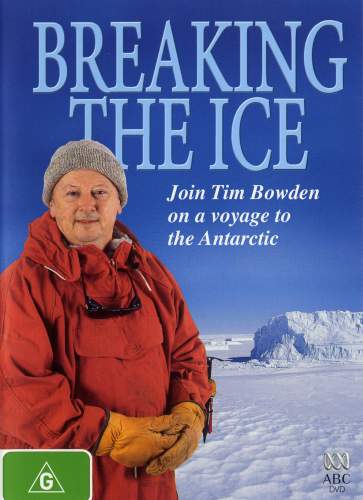Breaking the Ice (1996) |
|
Breaking the Ice (1996) |
|


|
| BUY IT |
| General | Extras | ||
| Category | Documentary | None | |
| Rating |

|
||
| Year Of Production | 1996 | ||
| Running Time | 166 | ||
| RSDL / Flipper | Dual Layered | Cast & Crew | |
| Start Up | Menu | ||
| Region Coding | 4 | Directed By | Ian Cuming |
|
Studio
Distributor |
 Roadshow Home Entertainment |
Starring | Tim Bowden |
| Case | Amaray-Transparent-Secure Clip | ||
| RPI | $29.95 | Music | Robert Moss |
| Video | Audio | ||
| Pan & Scan/Full Frame | Full Frame | English Dolby Digital 2.0 (224Kb/s) | |
| Widescreen Aspect Ratio | 1.29:1 | ||
| 16x9 Enhancement | No | ||
| Video Format | 576i (PAL) | ||
| Original Aspect Ratio | 1.33:1 | Miscellaneous | |
| Jacket Pictures | No | ||
| Subtitles | English for the Hearing Impaired | Smoking | No |
| Annoying Product Placement | No | ||
| Action In or After Credits | No | ||
In 1996 the ABC sent journalist, media commentator and sometime historian Tim Bowden on a two month journey to and around the Antarctic.
That journey is recorded in Breaking the Ice, a documentary series consisting of 6 episodes of roughly 30 minutes each. This is not a nature documentary, although penguins and seals occasionally feature. Instead it is a look at life in Antarctica for the Australians who staff the three stations in Antarctica as well as the station on Macquarie Island.
Bowden's task was to write a history of the Australian presence in Antarctica and one of the joys of the series is the occasional excerpts from films made by previous explorers and researchers, some of the footage dating back to 1911. Through these excerpts we really get an understanding of the harsh beauty of this world as well as the challenge of setting up and maintaining a working base.
This is not Attenborough and Bowden is an amiable though not compelling narrator. It is not high-tech and may disappoint anyone looking for breathtaking cinematography. The documentary is gentle in its approach, relying on the static images of the wilderness and the can-do spirit of Antarctic researchers to sell the show.
The Episodes are as follows:
Episode 1 - Macquarie Island. Tim travels on board the Australian icebreaker 'Aurora Australis' to Macquarie Island half way between Australia and Antarctica. This has a large seal community and those with tender stomachs may wish to miss the scene where the researchers pump the stomach of a seal (apparently it doesn't hurt!) to find out about the state of ocean fish stocks.
Episode 2 - The White World. Tim sees the first iceberg of the trip and he undergoes a ritual including a severe hair cut as an initiation given by the icebreaker crew to the Antarctic team who are to replace those who have spent the last year in Antarctica.
Episode 3 - Casey Station. Tim meets the outgoing crew of Casey Station and learns about Australia's unsuccessful previous settlement at Wilkes which was buried under snow so many times that the Australians just left and moved elsewhere.
Episode 4 - The Riviera of the South. Tim travels on the 'Aurora Australis' to Davis Station (named "the Riviera" because of its comparatively mild weather) through thick pack ice that threatens to halt the ship. We are reminded of the 1915 expedition where the wooden hulled "Endurance" was slowly crushed by the force of the ice. Tim rides an Antarctic motorbike to a weddel seal colony where one of the scientists proudly shows off her seal bite scars.
Episode 5 - The Midnight Sun. The episode opens with a spectacular shot of Tim standing on a huge drifting iceberg. On the way to Mawson station Tim visits the Chinese Antarctic station at Zhong Shan. It hard to believe that the Chinese are working in this environment without internal heating with the temperature inside a constant zero! Mawson Station was Australia's first Antarctic station, opened in the early 50's. Tim travels across the ice to the penguin rookery similar to the one made famous by March of the Penguins (apparently that is a rookery in the French part of Antarctica)but notes with concern the number of young penguins dead from unknown causes.
Episode 6 - Going Home. Tim's Antarctic journey is at an end but not before an emergency takes them off course back towards Davis to pick up an injured researcher. It is with some sadness that he leaves the frozen wasteland that has been home for two months.
Breaking the Ice is a ground-breaking documentary for the ABC. It gives some explanation of the history of the men and women who struggled and died to establish research stations in the harshest place on Earth. No-one should confuse this show for a nature program or an exciting documentary with recreations and drama throughout. There is little drama and the core of the show is insight and entertainment rather than spectacle.
Unfortunately, the transfer is not particularly good. The DVD is presented in its original 1.33:1 aspect ratio and is not 16x9 enhanced. This is not such a problem as the film does not really concentrate on wide open vistas as much as cramped living quarters.
It was filmed on video and even though it is barely ten years old the video quality is showing its age. There are minor but persistent artefacts and the grainy image is a regular distraction. Aliasing is an occasional issue. On a small screen these are minor problems but on a large screen they can be real annoyances.
Surprisingly, some of the vintage footage looks almost as good as the current image.
There are optional subtitles for the hearing impaired which are easy to read and give a good account of the dialogue and voice-overs.
| Sharpness | |
| Shadow Detail | |
| Colour | |
| Grain/Pixelization | |
| Film-To-Video Artefacts | |
| Film Artefacts | |
| Overall |
The sound is presented in English Dolby Digital 2.0 (224Kb/s).
The sound quality is appropriate for a program that largely consists of voice-over and interview. Surround surround and sub-woofer action is not missed.
The occasional music is enjoyable without being memorable.
| Dialogue | |
| Audio Sync | |
| Clicks/Pops/Dropouts | |
| Surround Channel Use | |
| Subwoofer | |
| Overall |
There are no extras.
NOTE: To view non-R4 releases, your equipment needs to be multi-zone compatible and usually also NTSC compatible.
This DVD is not available in Region 1.
Breaking the Ice is an important and enjoyable insight into the history of Australians in the Antarctic. What makes it so special is the fact that trips to Antarctica are by invitation only and aren't open to even the most intrepid adventure tourist. Tim Bowden gives us a rare insight into the lives of these determined Australians who give up a year of their lives in an inhospitable environment for the sake of science.
| Video | |
| Audio | |
| Extras | |
| Plot | |
| Overall |
| Review Equipment | |
| DVD | Onkyo DV-SP300, using Component output |
| Display | NEC PlasmaSync 42" MP4 1024 x 768. This display device has not been calibrated. This display device is 16x9 capable. |
| Audio Decoder | Built in to amplifier/receiver. |
| Amplification | Onkyo TX-SR600 with DD-EX and DTS-ES |
| Speakers | JBL Simply Cinema SCS178 5.1 |